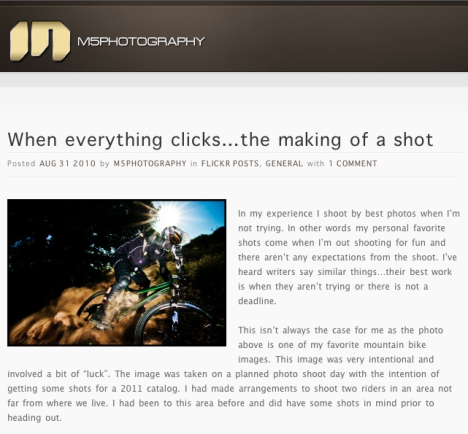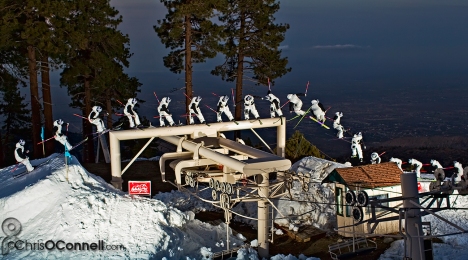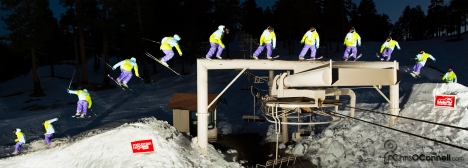With a degree in Plastic and Composite Engineering, Grant Gunderson is no stranger to fluid dynamics, torque, and tensile strengths. One can’t help but wonder if this training has helped nudge him in the area of photography he now makes a living in: high speed flash skiing photography.

K.C. Deane skiing at Sugar Bowl resort, Donner Pass. ©Grant Gunderson
As a young adult, Gunderson shot photos of friends skiing and snowboarding. After graduation, a hobby became a passionate profession he’s been engaged in for over a decade. An avid skier himself, Gunderson is well-acquainted with the physics of the sport, and accordingly knows what to expect as an athlete comes blasting down a mountain into view of his lenses. “I think that’s part of it,” he agrees. “The biggest portion of shooting something like skiing, or if you were shooting mountain biking, or any action sport, is if you’re not an avid participant, you really don’t know what’s going to create an image that’s really going to speak to people into those sports. I think you have to be a participant in order to document it properly.”
Beyond the physics, fully understanding all aspects of his subject matter is also critical to Gunderson’s holistic approach to capturing the world of skiers. In this way, he knows what the audience of publications he sells to want. “Skiing is a fairly small niche and I think if you’re going to succeed in ski photos you’ve got to be able to create images that speak to the culture of skiing, and not just create a unique photo,” he explains.

Zack Giffin sking at Mt. Shasta. ©Grant Gunderson
In the winters, he travels from his base in Washington State to anywhere in North America to capture downhill action. His main areas of concentration are Western Canada and the Western United States, but every major hot spot for skiing in both nations are also regularly visited. This year, he also traveled as far as Iceland and Norway for photo shoots. In the summer, he heads to South America to take advantage of winter skiing in the Southern Hemisphere.
Unlike many other sports, skiing and snowboarding present the interesting challenge of the terrain. Not only is he required to hike into mountain terrain with all his photographic gear, but there is the unyielding issue of snow and it’s preservation before a shot is set-up and executed. “If it’s a really unique location I’ve been to a lot, I’ll have an idea of how I want lighting that’s unique from what I’ve done in the past,” he explains. “Since we spend so much time traveling, we kind of have to let the location speak for itself. We’ll pull up to a location, and before we do anything, I have to have a pretty good idea of where the light’s going to go and what the skiers are going to do. Once you put a track in a shot, or once they ski through the snow, it’s done. You can’t do it over again. You have to get it right the first time.”

Adam skiing powder at Revelstoke Mountain Resort. ©Grant Gunderson
Getting to his locations is no small feat, either. “Everything we do is on our backs, so it’s a little bit of physical labor. Luckily, the athletes and the media I work with seem to be more than willing to carry some flash packs. They’re not exactly light,” he says, laughing.
Gunderson shoots a Canon EOS 1D Mark IV prototype. He avoids Photoshop and uses Lightroom to process his images. “I learned how to shoot on slides with Canon,” he says. Shooting digitally and only using Lightroom “keeps it kind of pure,” he explains.

Cody Barnhill skiing at Sugarl Bowl resort, Donner Pass. ©Grant Gunderson
To help freeze an athlete flying off a cliff, Gunderson relies on HyperSync technology from PocketWizard. “The HyperSync is whole new game‑changer,” he declares. “It’s the best. That’s the single most important technological advancement I’ve seen in the last decade.” An off-camera flash enthusiast for at least the last five years, he is very in tune with the latest gear developments which help him achieve his signature style.
Gunderson feels his saturation is one of the primary elements in his style. “I think the key to that is having proper off‑camera flash,” he says. “It gives that 3D look to it, where it doesn’t look too flat. Being on Mount Baker, we have the world record for snowfall, and we tend to get more snow than any place else, so sunny days are kind of a rarity for us, so flash is definitely key.”

Zack Giffin skiing at Mt. Baker, WA. ©Grant Gunderson
Often incorporating two Elinchrom Ranger packs, Gunderson explains his set-up. “I’ll use the PocketWizard FlexTT5 on a camera. Then I’ll use either two Plus II’s or two of the MultiMAX’s for each flash. I’ve done as much as seven flashes for a shot. But, with skiing, unless you’re starting to use a lot of color gels, you can usually get by with two or three main flashes, if you have enough power.”
Along with worrying about ruining virgin snow before a shot is captured, Gunderson says water interfering with his equipment is one of his biggest problems. “I’m probably using this gear in the harshest conditions you can find,” he says. “That’s one thing really cool about the PocketWizards is you can use them in an environment like this, then take them to the studio and they work just fine. It’s rarity you find a product that works that well in snow.”
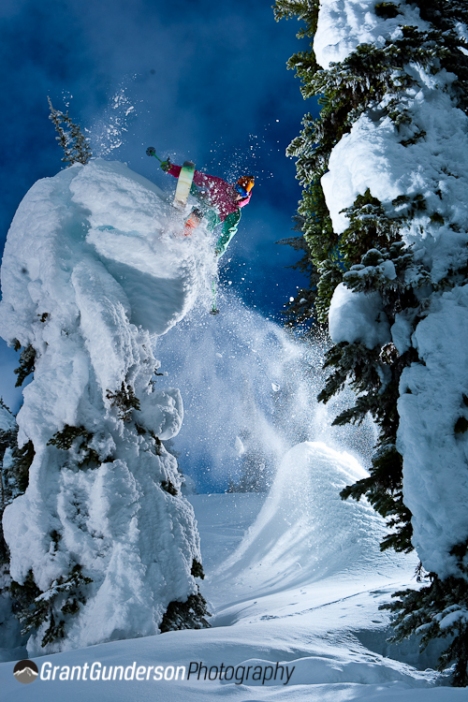
K.C. Deane skiing at White Water during the Cold Smoke Festival. ©Grant Gunderson
Gunderson does do some studio work, but for him, skiing is all about the action. “Skiing is more about the actual sport itself,” he says. “Sometimes it’s about the athlete, but I think it’s more of a way to provide an escape for the average viewer who wants to go skiing. For me it’s definitely a lot more about the action than it is the portraits.”
Also utilizing the lifestyle of the ski culture for his product photography, Gunderson keeps that work out of the studio as much as possible. “I don’t do as much of the actual straight product photography most people are used to,” he explains. “When we do the product photography, it’s more to show the product in the environment it’s used in. We’ll try to incorporate a form of lifestyle portrait shot, instead of just showing a strict product on top of a table. You shoot these outdoors in the snow, you’ve got to make the product look good and you have to make sure the equipment you’re using is actually performing.”
Shooting in these environments is not without risk to both humans and camera equipment. Gunderson reports a few rare incidents of people getting hurt in minor avalanches and gear getting swept away. “We try to be as safe as possible and not put ourselves in danger,” he says. “You’re on the mountains and if you don’t respect the mountains, they’re definitely going to fight you back. Any time you let your guard down something is going to happen.”

Zack Giffin skiing at Mt. Baker, WA. ©Grant Gunderson
With clients knowing they can trust Gunderson and his team, he enjoys a great deal of creative freedom. “We never really have an actual, physical shot list of, ‘You need to shoot this exact same push in the mountain, exactly like this,'” he says. “It’s always up to us how we want to make a living portrait of the place. We do a little bit of scouting beforehand, especially if we’re creating a more of a really unique and dramatic shot. Most of the time, we will go to the location and either hike around, or take snowmobiles out, or get the helicopter out until we find what we think will look best and just make it work on the spot.”
Gunderson explains how the below shot came to be, which utilized PocketWizard-triggered flashes. “That was shot at Alton, Utah, two years ago, for a ski magazine cover. They came up with an entirely new format for the magazine, so they wanted a really dramatic cover shot. That ended up being the first two‑page spread they ever used for a cover. It’s a combination of flash exposure combined with the very long exposure for the night. I think one thing that’s important to note is a lot of the stuff that looks like it’s been shot in the middle of the night was shot, not in full view, but in the late afternoon or early morning with filtering the bright out using the PocketWizard and very strong studio flashes, to be able make it look more night than it actually is. Using the PocketWizard now gives you a hell of a lot more creative control than what you used to be able to do.”
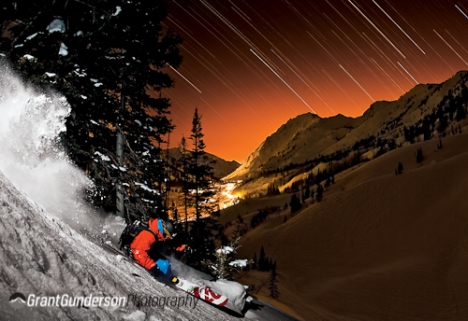
Bryce Phillips skiing powder at night under star trails in the Alta backcountry. ©Grant Gunderson
Reporting on his almost total use of HyperSync, Gunderson says, “The cool thing about hyper sync too, is you can use an extremely fast shutter speed to get rid of some of the ambient exposure, but you can create a much sharper image than you can with just a flash alone. When you use HyperSync, you’re using a very fast shutter speed, like a thousandth of a second. You’re just catching the absolute peak of the flash duration, so it’s the crispest image you can possibly come up with. That’s really exciting for me. You don’t have to do any sharpening. It used to be when you used flash, you would have to do a lot of sharpening.”
At the speeds his skiing subjects come flying at him down the side of a mountain, Gunderson is able to freeze the moment, including flying powder. “Normally, I get a lot of motion play even using these extremely fast strobes, but with HyperSync, the motion play is one hundred percent gone,” he says. “I’m pretty excited about PocketWizard’s HyperSync mode.”

Cody Barnhill skiing at Sugar Bowl Resort, Donner Pass. ©Grant Gunderson
The timing of strobes is not the only clock Gunderson is up against. “It’s always about how much gear we have to lug in, but the thing we worry about with skiing is acting fast,” he says. “We want to minimize the amount of time we’re in an environment, or possibly exposed to avalanche conditions and things like that. More importantly, if we are shooting in a ski resort, we’re not closing off trails to people. People are always free to ski when you’re shooting. So, if want to get a shot and make it look clean, we have to get there and set up really quick to get the shot before someone else comes and skis through it, without realizing what we are doing.” The general rule he follows is “the further you walk, the less people you’re going to find.”
Gunderson uses a Sekonic L-408 light meter to get readings on ambient light. “The problem is I can’t get the meter out there where the skiers are, where you need the flash exposure. We’ll meter the ambient, but we have to make an estimate as to what the flash is going to do.”
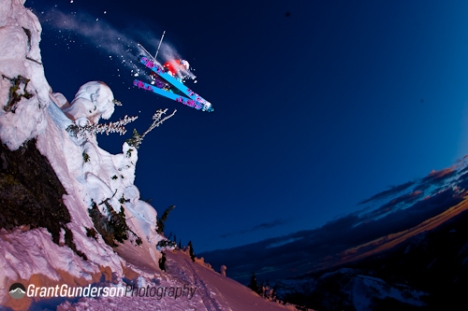
Adam skiing at White Water during the Cold Smoke Festival. ©Grant Gunderson
Not only has his gear changed the range of creativity Gunderson is able to pull off, it has also increased the range of images he gets on the critical first pass of any skier flying past him. “We only get one chance each time we shoot the photo, so we depend on our equipment to work every time, exactly how we hope it’s going to do. It’s awfully frustrating when stuff doesn’t go right, but the game is the game. There would probably be a lot more people doing it if it was easier. Without the flash, the motor drive can do ten frames per second—enough to do a sequence—but I definitely fire off a burst at the key point of it: make sure I’ve got the grab and make sure they’re in perfect position. When we started working the flash stuff, before the TT5, we didn’t know what exposure. The flash goes off, that’s it, you’re done, game over. But now with the TT5, that thing is really cool. The shutter speed is so fast, the shutter speed alone can start action, where we can get the first prime stuff with the flash. Then we can definitely get two or three other shots to go with it that are non‑flash. So we kind of get two or three shots for the same amount of work. That is pretty exciting to me: two or three really distinctive shots each time, whereas before it was just one. It has definitely increased productivity for us.”
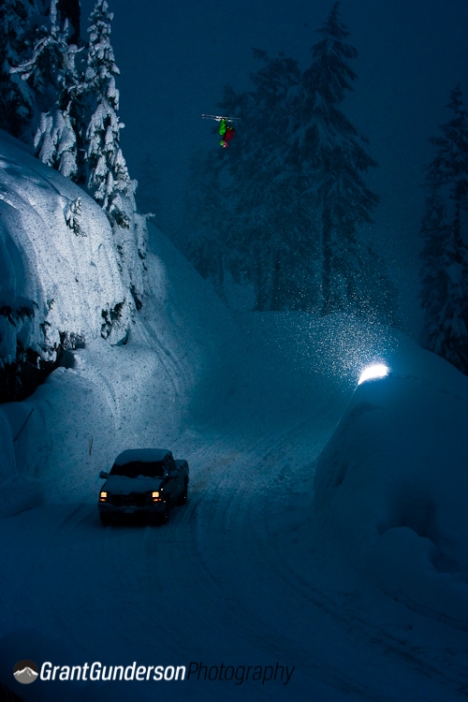
Dana Flahr throwing a very large lawn dart front flip over the Mt. Baker Road gap at dusk while filming for TGR. ©Grant Gunderson
As Gunderson’s career marches on, he remains fluid in both his adaptation of new photographic technology, and his creativity. Although we have limited space here to represent his work, the larger body of his photos show a surprising range of composition within the narrow range of skiers caught in midair. With his engineering background, it’s no surprise he understands controlled environments and the science behind high speed flash photography. What is surprising is his adept handling of the chaos ensuing when an athlete breaks from the trees a few yards away from him at a high rate of speed. Lucky for ski fans around the world, Gunderson is prepared and knows what to do.
Grant Gunderson Photography
Grant Gunderson Blog
The Ski Journal
Grant Gunderson on Facebook
Written by Ron Egatz
Filed under: behind the scenes, flextt5, high speed, how-to, hypersync, MultiMAX, off-camera flash, Plus II, PocketWizard, sports photography | Tagged: Grant Gunderson, hypersync | 4 Comments »













